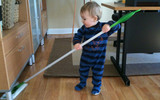6. How To Protect and Maintain Your Hardwood Floors

Hardwood flooring may increase the value of your home, but proper set up of
your rooms and having a regular maintenance routine are important in order
to prevent permanent damage to your flooring. Here are a few basic
recommendations for protecting your hardwood flooring.
General Tips for Living Well with Hardwood
- • Finishes: You want a tough one, but keep in mind that floor sealers which protect hardwood floors from scratching tend to be thicker. They may mask the wood’s natural look, and might make it more difficult to resurface.
- • Furniture Pads: When moving furniture throughout your home, rollers, felt, cork, rubber pads, a business card, a small cutout from construction paper, a cotton towel, a small area rug – any of these may be used underneath the pieces to protect your floors. You can attach wheels to chairs and desks. A chair or table leg can be sanded and oiled on the bottom until it has rounded sides, which should help prevent scratching while the furniture sits in place.
- • Rugs and Carpeting: Mats or rugs will protect hardwood floors from dirt in high traffic entrance areas. This is true of rugs placed both inside and outside the entrances. Most types of rugs will work, but don’t use rubber backed mats because they can lock in moisture and damage the floor.
- • Footwear: Eliminating footwear on hardwood lengthens the floor’s life and maintains the finish. That’s our longwinded way of saying take off your shoes when you come in. Hard heels or toes can be rough on hardwood flooring, and even soft bottomed footwear may scrape the floor by tracking in dirt and other objects. High heels? Just say no. These are quite simply not to be allowed on any hardwood floor. No hardwood, no matter how dense, no matter the sealant, will withstand high heels. They will dent, ever and always. No.
- • Pets: Definitely housebreak your pet, as pet urine will stain and decay hardwood floors over time in spite of quick clean-up. Pets can also dig their nails into hardwood flooring surfaces, but this can be avoided by keeping the nails groomed and just limiting their access to these areas. Other alternatives include pet booties and nail caps.
- • Home Exterior: Keep areas outside your home entrances clean swept, as dirt and debris can get tracked into your home by guests and pets as they enter. Pay special attention to high traffic areas such as entryways, garages and patios.
Maintenance Scheduling Tips
Daily
- • Clean as often as possible, sweep or dust regularly, and wipe up any spills as soon as they happen.
- • You will only damp-mop for any mop-like treatment. What chemicals you get to use will be determined by the instructions that come with your wood and with the finish. Using anything other than suggested cleaners may even void the warranty on your floor. Those supersede anything we’re about to say, but for those who’ve inherited a floor without documentation, we suggest the following guidelines.
-
While it is all but inevitable that a hardwood floor will need to be
recoated eventually regardless of how you clean it, there are still better
and worse options for what to use.
- Cleaning Chemicals
-
The Bad
Not good enough – Just water or vinegar plus water won’t remove all the dirt, and in some cases will just spread it around into a dull film. The vinegar may also prematurely dull the finish.
Residue leavers – ammonia, bleach, furniture spray, oil based cleaners and wax will leave a residue.
Scratchers – abrasive cleaners (like Soft Scrub), alkaline cleaners, and ammonia again will dull the shine with micro-scratches
The Good
Your manufacturer’s recommended cleaner, as we said above
A water based cleaner that is pH neutral – neither acidic nor basic. A lot of vinyl cleaners meet this standard.
Plain soap and water -
1. Dust. You can use something like a Swiffer, disposable cloths, or
a floor brush attachment on a vacuum cleaner. No ‘beater-bar’.
2. Prepare your liquid.
3. Dip your mop in and then wring it out completely, probably twice. It should not drip at all. No drips.
4. When you mop, move in the direction of the wood grain if possible (we realize some of them swirl about, and unless you’re a tiny faerie from Fantasia, skating around with mop slippers, sometimes this will be impossible).
5. When the cleaning liquid gets dirty, empty it out of the bucket, rinse out the bucket (you’ll be surprised how much grit will stay after the first pour out), and then mix up some more of your cleaning chemicals.
6. Once you’ve finished going over the floor, replace your cleaning water with plain, very clear water. Repeat steps 3-5 using just the water to pick up any residue from the cleaning agent and pick up any remaining grit.
The MethodIf humidity is high, use a ceiling or floor fan to dry the floor quickly as you go through this process.
Monthly or Quarterly
- • Be aware of any expansion and contraction in your hardwood flooring. Maintain air conditioning and humidity levels at acceptable levels to control moisture damage throughout the seasons.
- • Dirt and debris accumulates on your floor, increasing the risk of scratches. Avoid using stiff bristled booms, wet mops, and vacuums with beater bars or wheels when cleaning this up from your hardwood floors. Softer brooms, mops, and vacuums (without the bars) are the primary tools designed for this purpose. Your goal is to get the stuff up, but not push it around against your floor surface.
- • To dissolve any grease or dirt build-up, you can use an alkaline water-based cleaner in those spots, but regular soap, or a bit of baking soda and water should also work. Remember that alkaline solutions do dull many hardwood finishes, so this is just for spots.
- • Small simple scratches can be repaired with oils and scratch-removing sprays, while deep scratches require wood fillers and repairing chemicals.
• Home stores may offer hardwood fix-it kits with oils that can make scratches less visible, a quick and easy way to fix your scuffed and scarred floors.
Yearly or As Needed
-
• Renew the finish with a light sanding and fresh coat
of polyurethane.
• Re-arrange furniture and rugs periodically to redistribute stress and age the floor’s finish. This will keep your hardwood floor looking new. Window treatments can also reduce sun damage.
Follow these recommendations and you should be able to maintain your
hardwood floors’ beauty! Always check with a flooring professional should
you have any questions.
– – – –
David has written and made videos about flooring products and installation since 2011 at Floors To Your Home (.com), where he is also the PPC Manager, a Researcher, a Website & Marketing Strategy Team member, Videographer, Social Strategist, Photographer and all around Resource Jito. In my spare time I shoot and edit video, put together a podcast, explore film history, and mix music (as in ‘play with Beatles multi-tracks’). Connect with
W. David Lichty
Follow Team Floors To Your Home on Facebook

 Brown Tone
Brown Tone
 Red Tone
Red Tone
 Golden Tone
Golden Tone
 Gray Tone
Gray Tone
 Light Tone
Light Tone
 Medium Tone
Medium Tone
 Dark Tone
Dark Tone
 Multi Color
Multi Color

